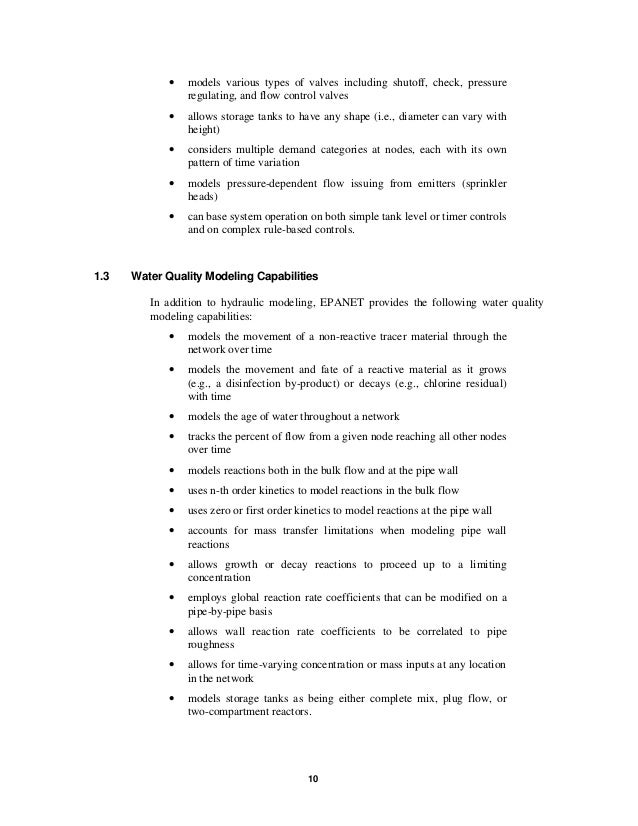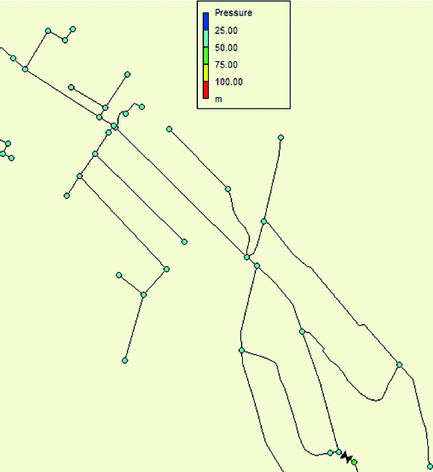- Download Epanet 2.0 Software
- Download Epanet 2.0 Crack
- Download Epanet 2.0 English
- Download Epanet 2.0 Download
This page is hosting some EPANET-related resources. Download EPANET 2.00.12. EPANET for Windows 7 and 8 - Inptools includes Windows integration and additional tools; EPANET for older Windows versions; EPANET for Mac OS X, OS X 10.9 Mavericks, OS X 10.8 Mountain Lion, OS X 10.7 Lion or OS X 10.6 Snow Leopard with an Intel processor. EPANET is a software program destined to be used by professionals who analyze, simulate and manage water distribution piping systems. It can be used to evaluate alternative strategies for improving water quality, to design and upgrade the performance of a hydraulic system, or to realize assessments about consumer exposure.
EPANET, free download. EPANET 2.0: Unknown Publisher. EPANET is a Shareware software in the category Desktop developed by Unknown Publisher. It was checked for updates 188 times by the users of our client application UpdateStar during the last month. Free epanet 2.0 下载 download software at UpdateStar - VLC Media Player Foot Pedal allows VLC Media Player to be used as transcription software for transcription of all types of media files with full foot pedal support.
Published June 22, 2020EPANET mock up of a water system
Download Epanet 2.0 Software
Protecting and maintaining drinking water distribution systems is crucial to ensuring high quality drinking water. The purpose of a water distribution system is to deliver water to consumers with appropriate quality, quantity, and pressure, from its source to the point of use. The optimal management of these systems requires data and information, including a digital model of the water system depicting its pipes, valves, pumps, tanks, and other attributes.
EPANET was developed by EPA in the 1990s to better understand water quality transport processes in drinking water distribution systems. Dr. Lewis Rossman, an environmental engineer, created EPANET, a user-friendly software application for modeling the hydraulic and water quality behavior of distribution systems. Since then, EPANET has been used by water utilities engineers, consultants, government officials, and academics in the United States and around the world to help design, manage, and understand water systems. EPANET is also used to model contamination threats and evaluate resilience to security threats or natural disasters.
The first official release of EPANET 2 was version 2.00.05 on June 1, 2000. Between 2000 and 2008, EPA published six significant updates for EPANET. However, more frequent updates are increasingly needed; as well as efforts to modernize the EPANET code base and add the many improvements the research community had developed and published. EPANET is becoming a more widely used and relied upon modeling software tool nationally and world-wide. With only a few EPA scientists well versed on detailed functions of EPANET, they are unable single-handedly, to provide timely software updates.
“With EPA’s last official release of EPANET occurring in 2008, it has become increasingly more difficult for EPA to maintain and advance EPANET on a regular basis and meet the needs of the EPANET community,” said Robert Janke, EPA research scientist and EPANET project officer.
In 2015, the Water Distribution System Analysis (WDSA) Standing Committee voted to initiate an open source software project for the continued development of EPANET. This committee is a part of the Environmental and Water Resources Institute (EWRI) - a technical institute of the ASCE (American Society of Civil Engineers. With the announcement of an open source EPANET initiative, the project indicated that it would be owned and managed by the wider WDSA community without affiliation to any private or public for-profit institution or company. In so doing, software developers from EPA and the water community came together via the community organization and forum, Open Water Analytics (OWA), to form and promote an initiative for an open source EPANET. This is a community-organized initiative to maintain and extend EPANET in the public domain. The EPANET developers’ community at OWA is composed of dedicated volunteers from around the world who have a passion for EPANET.
The recently released EPANET 2.2.0 would not have been possible without the dedicated community of volunteer software developers at OWA. EPA’s release of EPANET 2.2.0 represents a collaboration with the WDSA Standing Committee of the EWRI and the community at OWA. It also represents a new, community-based open source software approach to maintaining and advancing EPANET. EPANET 2.2.0 includes numerous substantial improvements over the former version. These include updates to the hydraulic and water quality engines by providing faster, more accurate, and more robust results compared to its predecessor. Everyone is welcome to participate in the EPANET project. Whether helping others to resolve issues, reporting a new unknown issue, suggesting a new feature that would benefit a workflow, or writing code, EPA value’s and appreciate the time and effort of all contributors. The path for contribution starts with entering an issue at https://github.com/OpenWaterAnalytics/EPANET/issues. Examine the open issues at this link and the conversation around them, and then get engaged!
EPANET 2.2.0 provides an updated and expanded open source water distribution system modeling tool to meet the vastly important needs of water utilities and the water community.
Learn More
Download Epanet 2.0 Crack

EPANET is a public-domain, water distribution system modeling software package developed by the United States Environmental Protection Agency's (EPA) Water Supply and Water Resources Division. It performs extended-period simulation of hydraulic and water-quality behavior within pressurized pipe networks and is designed to be 'a research tool that improves our understanding of the movement and fate of drinking-water constituents within distribution systems'.

Pipe networks consist of pipes, nodes (junctions), pumps, valves, and storage tanks or reservoirs. EPANET tracks:
- the flow of water in each pipe,
- the pressure at each node,
- the height of the water in each tank, and
- the type of chemical concentration throughout the network during a simulation period,
- water age,
- source, and
- tracing.
EPANET's Windows user interface provides a visual network editor that simplifies the process of building piping network models and editing their properties and data. EPANET provides an integrated computer environment for editing input data. Various data reporting and visualization tools are used to assist in interpreting the results of a network analysis. These include
- color-coded network maps,
- data tables,
- energy usage,
- reaction,
- calibration
- time series graphs,
- profile plots
- contour plots.
EPANET provides a fully equipped, extended-period hydraulic analysis package that can:
- Simulate systems of any size
- Compute friction head loss using the Hazen-Williams, the Darcy Weisbach, or the Chezy-Manning formula
- Include minor head losses for bends, fittings, etc.
- Model constant or variable speed pumps
- Compute pumping energy and cost
- Model various types of valves, including shutoff, check, pressure regulating, and flow control
- Account for any shape storage tanks (i. e. , surface area can vary with height)
- Consider multiple demand categories at nodes, each with its own pattern of time variation
- Model pressure-dependent flow issuing from sprinkler heads
- Base system operation on simple tank level, timer controls or complex rule-based controls
In addition, EPANET's water quality analyzer can:
- Model the movement of a non-reactive tracer material through the network over time
- Model the movement and fate of a reactive material as it grows (e. g. , a disinfection by-product) or decays (e. g. , chlorine residual) over time
- Model the age of water throughout a network
- Track the percent of flow from a given node reaching all other nodes over time
- Model reactions both in the bulk flow and at the pipe wall
- Allow growth or decay reactions to proceed up to a limiting concentration
- Employ global reaction rate coefficients that can be modified on a pipe-by-pipe basis
- Allow for time-varying concentration or mass inputs at any location in the network
- Model storage tanks as being complete mix, plug flow, or two-compartment reactors
* EPANET download link provides public domain version of the software.
Download Epanet 2.0 English
DFLOW 3. 1 is a Windows-based tool developed to estimate user selected design stream flows for low flow analysis and water quality standards.

Download Epanet 2.0 Download
WATER9, the wastewater treatment model, is a Windows based computer program and consists of analytical expressions for estimating air emissions of individual waste constituents in wastewater collection, storage, treatment, and disposal facilities; a datab
REMChlor, or Remediation Evaluation Model for Chlorinated Solvents, is an analytical solution for simulating the transient effects of ground water source and plume remediation.
The Industrial Waste Management Evaluation Model software is designed to assist you in determining the most appropriate waste management unit design to minimize or avoid adverse ground water impacts.
GSFLOW is a coupled Groundwater and Surface-water FLOW model based on the integration of the USGS Precipitation-Runoff Modeling System (PRMS-V) and the USGS Modular Groundwater Flow Model (MODFLOW-2005 and MODFLOW-NWT).
The computer program (HST3D) described in this report simulates heat and solute transport in three-dimensional saturated ground-water flow systems.
No comments yet. Be the first to comment.
Submit a review using your Facebook ID